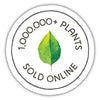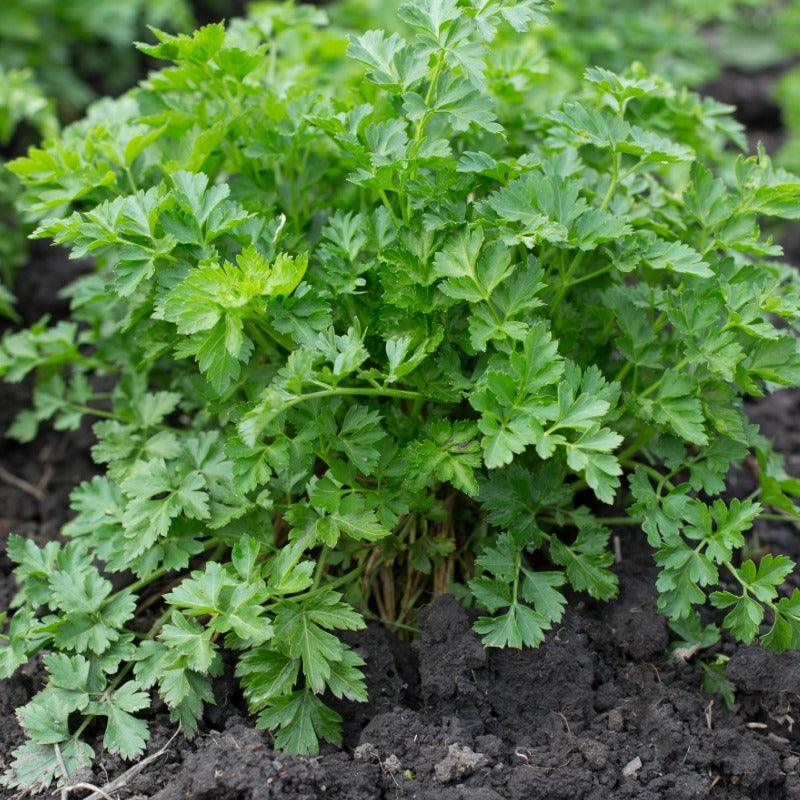Item Number: PV166
Organic Parsley
Low-Maintenance, Biennial, Offers Bright Flavor
A vibrant herb, elevates culinary experiences with its distinct flavor and versatility. Rich in vitamins A and C, parsley boasts health benefits. Thriving in well-drained soil and sunlight, it's an easy-to-grow biennial. Widely used in salads, soups, and garnishes, its crisp taste enhances diverse cuisines. A nutritional powerhouse, parsley transcends the kitchen, offering both culinary delight and potential health perks to those who embrace its culinary and botanical wonders.
Sustainably grown in 2.75" pots
Selecting the Right Location:
Choose a sunny location for growing parsley, as it thrives in full sun to partial shade. Ensure the site receives at least 6-8 hours of sunlight daily. Parsley prefers well-drained soil with a pH level between 6.0 and 7.0. Amend heavy clay soils with organic matter such as compost to improve drainage and soil structure.
Preparing the Soil:
Before planting, loosen the soil to a depth of 8-10 inches and remove any weeds or debris. Incorporate organic matter such as compost or aged manure into the soil to enrich it with nutrients and improve moisture retention.
Planting Parsley:
Parsley can be grown efficiently from transplants. Transplant seedlings into the garden, spacing them 8-10 inches apart. Water the transplants thoroughly after planting to help them establish.
Watering and Care:
Keep the soil consistently moist but not waterlogged, as parsley prefers evenly moist conditions. Water deeply whenever the top inch of soil feels dry to the touch. Mulch around parsley plants to help retain moisture, suppress weeds, and regulate soil temperature. Fertilize parsley plants sparingly with an organic, balanced fertilizer to avoid excessive foliage growth at the expense of flavor.
Managing Pests and Diseases:
Monitor parsley plants regularly for signs of pests such as aphids, caterpillars, or parsley worms. Handpick any pests and use organic insecticidal soap as needed. Practice crop rotation to prevent the buildup of soilborne diseases and pests. Avoid planting parsley in the same location year after year.
Harvesting Parsley:
Begin harvesting parsley leaves once the plants reach 6-8 inches in height. Harvest outer leaves first, leaving the inner leaves to continue growing. Use sharp scissors or garden shears to cut parsley stems just above the soil level. Regular harvesting encourages new growth and prolongs the harvest period. Avoid harvesting more than one-third of the plant at a time to ensure continued vigor and productivity.
Storing Parsley:
Store freshly harvested parsley in the refrigerator wrapped in a damp paper towel or placed in a plastic bag. It can stay fresh for up to two weeks when stored this way. Alternatively, preserve parsley by drying or freezing it. To dry parsley, tie bunches of stems together and hang them upside down in a dry, well-ventilated area until completely dry. Store dried parsley in airtight containers. To freeze parsley, chop the leaves finely and place them in ice cube trays filled with water. Once frozen, transfer the parsley cubes to freezer bags for long-term storage.
Benefits of Organic Parsley:
Organic parsley is free from synthetic pesticides and fertilizers, making it a healthier choice for both you and the environment. Parsley is rich in vitamins A, C, and K, as well as essential minerals like calcium and iron.
Incorporating Parsley into Your Diet:
Use fresh parsley as a garnish for soups, salads, and main dishes to add color and flavor. Blend parsley into smoothies or juices for an extra nutritional boost. Make homemade parsley pesto by combining parsley leaves, garlic, nuts, Parmesan cheese, and olive oil in a food processor. Experiment with parsley in recipes for tabbouleh, chimichurri sauce, or parsley butter.
Growing organic parsley is a gratifying experience that offers numerous culinary benefits. By following these guidelines for planting, caring for, and harvesting parsley, you can enjoy a bountiful supply of fresh, flavorful herbs throughout the growing season. Whether used as a garnish, seasoning, or main ingredient, organic parsley adds vibrancy and nutrition to a wide range of dishes, making it a valuable addition to any garden or kitchen.




Check Your Zone Compatibility:
Compatible with your zone.
Growing Zone for

Our Guarantee To You
Since 1976, we've served our customers at every stage of growing. Please contact us at any time. We are happy to support and assist you.
Shipping Information
Shipping Information
Shipping Weight: 0.5 lb
Features
Features
- Attracts Bees/Butterflies
- Container Compatible
- Does Not Require Support
- Greenhouse Compatible
- Mild Flavor
- Open-Pollinated
- Requires Summer Water
- Somewhat Drought Tolerant
- Useful for Ornamental
Characteristics
Characteristics
Planting & Care
Planting & Care
Soil & Water: Parsley prefers loose, moderately fertile soil with plenty of added organic matter. Water lightly.
Planting & Growing: Plant Parsley outdoors after the danger of frost has passed and soil temperatures have warmed to at least 50°F (10°C). Space plants 8-12 inches apart in rows or clusters. .
Harvesting & Storage: Harvest leaves and stems once they are large enough. Parsley flavor improves with successive cuttings. You can also harvest the whole plant, cutting at the soil level, and it will regrow. Pot up a plant for indoor, winter production.
Useful Information
Useful Information
Guarantee
Guarantee
We guarantee the perishable items we sell to be in good, viable condition when we sell them. Perishable items include, but are not limited to, garlic bulbs, flower bulbs, seed potatoes, onion sets & transplants, potted or bare root trees, vegetable crowns, etc. If your perishable item arrives in substandard condition, take photographs and please contact us within 3 days of the purchase date (or delivery date) and we will provide you with a refund of the purchase price (excluding shipping costs), or a replacement. Accordingly, we urge you to open any boxes marked as ""Perishable"" immediately upon receiving them and inspect the shipment thoroughly (do not crack open heads of garlic, we do not accept claims on cracked garlic). Because some perishable items can deteriorate very quickly, we cannot accept any claims beyond the 3-day time frame as it becomes too difficult to determine if these items were delivered in substandard condition, or if they turned into such substandard condition because of having been improperly cared for or stored once delivered.
Share


